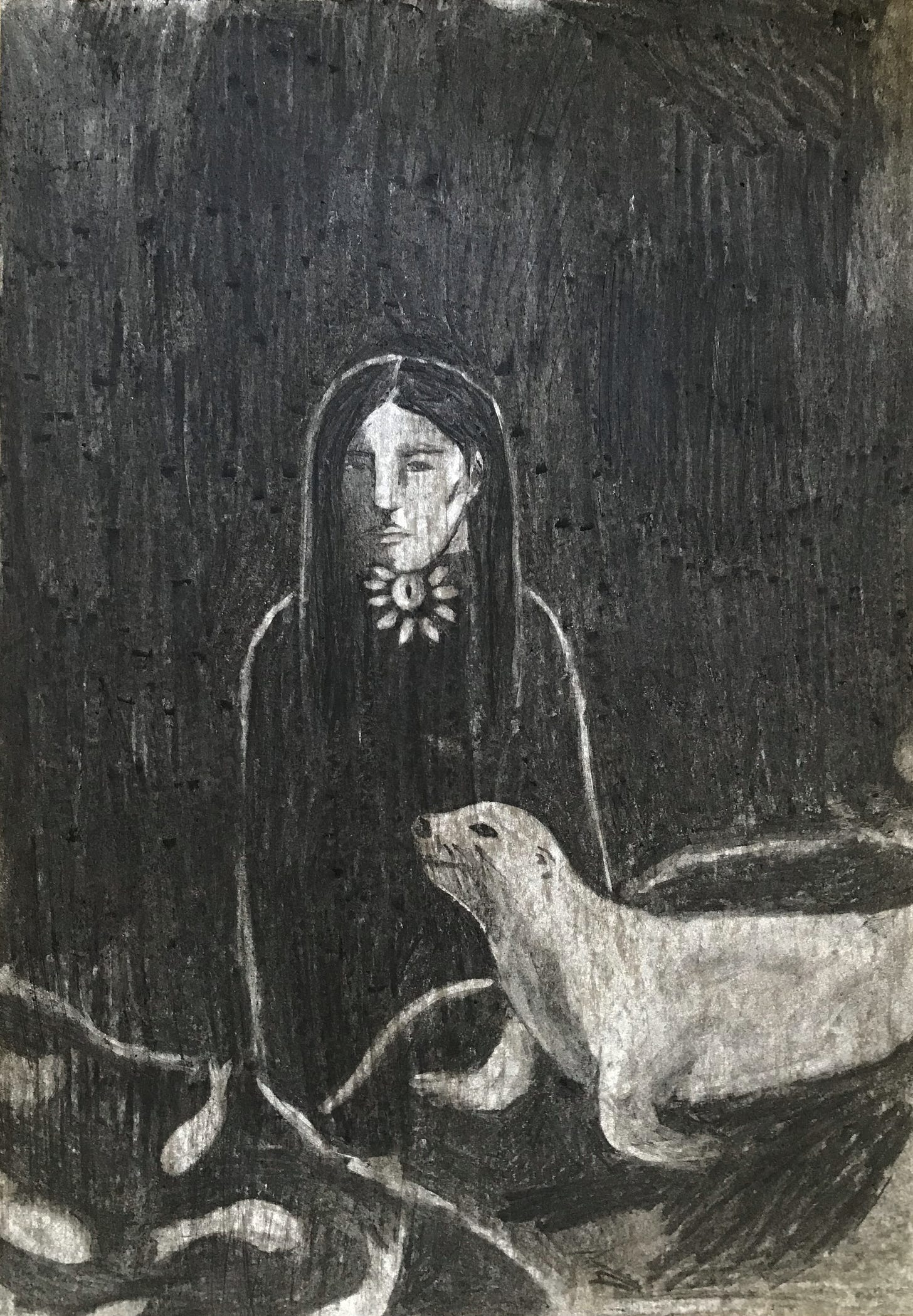Capture (30.09.2024)
A woman looks at us, eyes fixed and open. Mysterious woman, her ear exposed and listening. Parts of her are formed and brought to light and other parts slip into shadow. At her throat, a necklace or broach. An emblem - something like a flower, or perhaps a lock. I wonder where the key is and what it would open. What song would break-through and pierce this world? I imagine it is a song of longing. A Selkie song. This seal, soft skin, animal body. And these little fish, they seem to be swimming round and round in a dark pool of water, captured.
Selkie Song
Curl the hair away from your ear and listen -
What song springs from your soft skin?
From your soft animal body?
A key to open
To pierce into the world
From the shadows
It is formed
This soft animal song
Longing to be heardAs a child, I was fascinated by the story of selkies (seal skin, soul skin). Selkies are mythological seals who can shed their skin and roam on land in human form. Upon slipping back into their animal skins, they return to their seal form and to the sea.
In the version of the story I grew up with, a fisherman falls in love with a selkie in her human form and steals her seal skin. Unable to return to the sea, she lives with him on land, raising a family and shaping a life, but she painfully longs to return to the sea. Her husband hides the skin from her for many years, until, one day, her daughter helps her to find it. She leaves her family, slips into her seal skin, and returns to the sea, never surfacing to land again.
The selkies are creatures of liminality and transformation, moving between land and sea, animal and human. Through shedding they reveal their human form. It is a vulnerable act, to shed and reveal a hidden inner form.
I wonder what inner forms are inside each of us. I wonder what animal skins we have shed and hidden, and which ones have been taken from us. I wonder which animal skin we have longed to return to, to slip on, and change form. I wonder how the loss of all of these different skins has shaped us.
Caught between land and sea, the selkie lives a life of longing and in-betweenness. She hears the selkies’ song, a painful reminder of her other unlived life. In this story it is either or, it is land or sea. Where once she may have moved between the two worlds, shedding and inhabiting her animal skin, she now has to choose which world to rest in.
I am curious about longing and what it means to live in longing without, necessarily, finding a final form.
In my creative work with children I have noticed how drawn they are to caves, to the sea, to the belly of the whale. How their stories often take place at night time. How they inhabit the howling wolf, looking up at the moon. There is something in them, that knows, so deeply, the experience of longing - of having once been merged with the mother’s body.
I think this is why the selkie story affected me so much as a child, it spoke to me about longing, about the piece of me that could look towards the sea and wonder how it would be to return to her again.
I will leave you with a poem by Rainer Maria Rilke
Go to the limits of your longing
God speaks to each of us as he makes us,
then walks with us silently out of the night.
These are the words we dimly hear:
You, sent out beyond your recall,
go to the limits of your longing.
Embody me.
Flare up like a flame
and make big shadows I can move in.
Let everything happen to you: beauty and terror.
Just keep going. No feeling is final.
Don’t let yourself lose me.
Nearby is the country they call life.
You will know it by its seriousness.
Give me your hand.






Hi, Amy. Your writing reminded me of this quote I had found and written down some time ago:
“Perhaps my Indian nature is the moaning wind which stirs them [school teachers] now for their present record. But, however tempestuous this is within me, it comes out as the low voice of a curiously colored seashell, which is only for those ears that are bent with compassion to hear it.”
- from Zitkála Sá’s autobiography
Zitkála Sá was an early 20th-century Native American activist, author, and musician. Otherwise, I know little about her.
I also had the the thought that the flower/necklace placed at the throat called up images of the voice as with the little mermaid of Hans Christian Anderson, and the loss of that voice for her in her human form.
Apart from that, the world seems replete with stories of men falling in love with magical female beings and finding ways to trick them or keep them from being their true selves. No matter what love may exist between the two characters, such narratives strike me as troubling but perhaps reflective of our human nature.
Beautiful, mysterious imagery as always, Amy, and very thought provoking. Thank you!
No, no feeling is final.